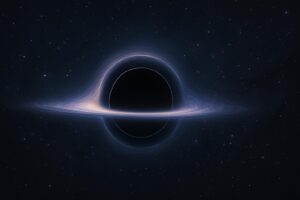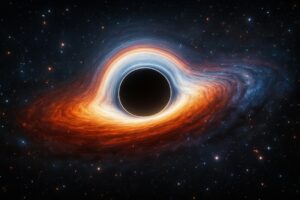Black Holes: Cosmic Mysteries Unveiled
Black holes are some of the most mysterious and intriguing objects in the universe. These regions of spacetime create such strong gravitational effects that nothing, not even particles or light, can escape from them. General relativity predicts that a compact mass can warp spacetime, forming a black hole. The edge of the area from which nothing can escape is known as the event horizon. While the event horizon significantly influences the fate of an object that crosses it, there are no detectable features in the vicinity.

For centuries, black holes existed only as theoretical ideas, mathematical puzzles born from Albert Einstein’s equations of general relativity. However, recent advancements in astronomy and physics have turned them from abstract concepts into real objects. Today, black holes are key to our understanding of the universe. They play important roles in the development of galaxies, the behavior of star systems, and the structure of spacetime itself. This article explores the fascinating world of black holes, looking into their formation, basic properties, various types, and their importance in modern astrophysics.
Formation of Black Holes
Black holes mainly form through the gravitational collapse of massive stars at the end of their life cycles. This process is both dramatic and energetic, often ending in a supernova explosion. The specific way a black hole forms depends on the star’s initial mass.

Stellar-Mass Black Holes
Stellar-mass black holes are the most common type and form from the remnants of massive stars. Stars with an initial mass of at least 8 to 20 times that of our Sun can become black holes. During their lives, these stars produce energy through nuclear fusion, mainly converting hydrogen into helium in their cores. The outward pressure from fusion balances the inward pull of gravity, keeping the star stable.
However, when a massive star runs out of nuclear fuel, fusion stops. Without the outward pressure to fight gravity, the star’s core collapses quickly under its own weight. This collapse can lead to a supernova, a bright and powerful explosion that blasts the star’s outer layers into space. If the remaining core is massive enough, typically more than about 2.5 to 3 times the mass of the Sun (known as the Tolman-Oppenheimer-Volkoff limit), the gravitational collapse continues beyond the neutron star stage. The core compresses indefinitely, leading to the formation of a singularity, a point of infinite density, and creating a stellar-mass black hole.
Supermassive Black Holes
Supermassive black holes (SMBHs) are massive, with weights from millions to billions of times that of the Sun. They are found at the centers of nearly all large galaxies, including our Milky Way, which contains Sagittarius A*. Researchers still explore how SMBHs form, and their origins are not as well understood as those of stellar-mass black holes. Several theories try to explain their creation:
- Direct Collapse: One idea suggests that SMBHs could have formed directly from the collapse of large gas clouds in the early universe, skipping the star stage. These clouds would have been very dense and quickly cooled, allowing them to collapse gravitationally into a black hole with an initial mass ranging from thousands to hundreds of thousands of solar masses.
- Seed Black Holes: Another theory proposes that smaller black holes, originating from the first stars (Population III stars), acted as ‘seeds’ that grew over time by drawing in gas and dust from their surroundings and merging with other black holes.
- Galaxy Mergers: Merging galaxies likely play a significant role in how SMBHs grow. When two galaxies collide, their central black holes may eventually merge, leading to an a an even larger supermassive black hole. This process can also funnel large amounts of gas and dust towards the center of the galaxy, fueling the growth of the existing SMBH through accretion.
Intermediate-Mass Black Holes
Intermediate-mass black holes (IMBHs) are a relatively new theoretical category, with masses between 100 and 100,000 times that of the Sun. Their existence remains debated, and there is limited observational evidence. They are thought to be a ‘missing link’ between stellar-mass and supermassive black holes. Possible formation methods include the quick collision of massive stars in dense star clusters or the collapse of very massive stars in the early universe.
Primordial Black Holes
Primordial black holes are theoretical objects that may have formed shortly after the Big Bang. Unlike other types, they would not have derived from collapsing stars. Instead, they could have originated from density fluctuations in the extremely hot and dense plasma of the early universe. If these fluctuations were large enough, they could have collapsed under their own gravity to form black holes of various sizes, from tiny to supermassive. Their existence has not been confirmed, but they are an intriguing area of study that could shed light on early universe conditions and even contribute to understanding dark matter.
Properties of Black Holes
Black holes have a few key properties, usually summarized by the “no-hair” theorem. This theorem states that a black hole is described only by three independent physical parameters: its mass, electric charge, and angular momentum (spin). Other information about the matter that formed the black hole or fell into it is thought to be lost.
Mass, Electric Charge, and Angular Momentum (Spin)
The mass of a black hole is its most defining feature. It affects the size of its event horizon and the strength of its gravitational pull. While it is theoretically possible for a black hole to have an electric charge, scientists generally think that astrophysical black holes have very little charge. Most black holes are expected to have angular momentum (spin), inheriting it from the stars they were formed from or the matter they attract.
Event Horizon and Singularity
The event horizon is the boundary around a black hole where nothing can escape. It is not a physical surface but rather a point of no return. At the center lies the singularity, a point in spacetime where density and the gravitational field are predicted to be infinite. Our current understanding of physics breaks down at the singularity, requiring a theory of quantum gravity for a full description.
Accretion Disk and Jets
While black holes themselves are invisible, we can infer their presence by observing their effects on surrounding matter. Black holes frequently pull in gas and dust, forming a swirling structure known as an accretion disk. This disk heats to extreme temperatures, emitting intense X-rays. In some cases, powerful jets of plasma can be expelled from the poles of the black hole, stretching thousands of light-years into space.
Types of Black Holes
Black holes are typically classified by their mass. The most widely accepted categories are stellar-mass, intermediate-mass, and supermassive black holes.
Stellar-Mass and Supermassive Black Holes
Stellar-Mass Black Holes are the most common, ranging from about 3 to several tens of solar masses. Supermassive Black Holes (SMBHs) are the largest kind, weighing from hundreds of thousands to billions of solar masses, and are found at the centers of most large galaxies.
Intermediate-Mass and Other Theoretical Types
Intermediate-Mass Black Holes (IMBHs) are a theoretical ‘missing link’ between the other two types. Other hypothetical types include Primordial Black Holes, which may have formed in the early universe, and Micro Black Holes, tiny objects predicted by some theories that would evaporate almost instantly.
Significance in Modern Astrophysics
Black holes, once seen as mere theoretical oddities, are now central to modern astrophysics. Studying them offers unique insights into gravity, spacetime, galaxy evolution, and the fundamental laws of physics. They serve as natural laboratories for testing General Relativity, are deeply connected to galaxy evolution, and have opened the new field of gravitational wave astronomy.
Conclusion
Black holes, from their explosive births to their massive presence at the centers of galaxies, continue to challenge and broaden our scientific understanding. They serve as cosmic laboratories for testing physics, influencing galactic evolution, and allowing us to explore the universe in new ways. Ongoing studies promise to reveal even deeper secrets about gravity, the origins of the universe, and the fundamental laws governing reality.
References
[1] NASA Science. Black Hole Basics. Available at: https://science.nasa.gov/universe/black-holes/
[2] Wikipedia. Black hole information paradox. Available at: https://en.wikipedia.org/wiki/Black_hole_information_paradox


Why visitors still make use of to read news papers when in this technological world the
whole thing is available on net?
Thank you !!